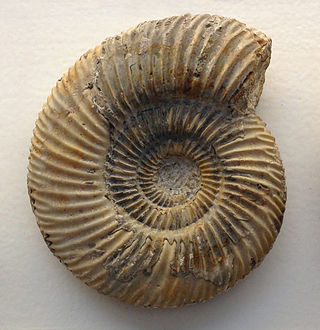Joseph John Sepkoski Jr. was a University of Chicago paleontologist. Sepkoski studied the fossil record and the diversity of life on Earth. Sepkoski and David Raup produced a new understanding of extinction events, by developing a statistical approach to the study of taxonomic diversification. He suggested that the extinction of dinosaurs 66 mya was part of a cycle of mass extinctions that may have occurred every 26 million years. But his most important contribution was the identification of the "Big 5" mass extinctions, events that have shaped the evolution of life on earth.

Aulacostephanus is an extinct ammonoid cephalopod genus from the Upper Jurassic Tithonian belonging to the perisphinctoidean family Aulacostephanidae.

Hyperlioceras is an extinct genus of cephalopod included in the ammonitid family Graphoceratidae that lived during the Bajocian stage of the Middle Jurassic. The type species is Hyperlioceras discites

Exiteloceras is an ammonite genus from the Late Cretaceous.

Phylloceras is an extinct genus of ammonoid cephalopods belonging to the family Phylloceratidae. These nektonic carnivores lived from Early Jurassic to Late Cretaceous.

The Aspidoceratidae comprise a family of middle and upper Jurassic ammonites that make up part of the superfamily Perisphinctoidea, characterized by evolute shells, commonly stocky, that tend to develop tubercles.

Calycoceras is an extinct genus of cephalopods belonging to the subclass Ammonoidea and family Acanthoceratidae that lived during the Cenomanian stage of the Late Cretaceous, 100-94 Mya. Their shells had ornate ribs.
Saxoceras is a genus of very evolute schlotheimiid ammonoids from the Lower Jurassic.

Harpoceras is an extinct genus of ammonite belonging to the family Hildoceratidae. These cephalopods existed in the Jurassic period, during the Toarcian age from the Falciferum zone to the Commune subzone of the Bifrons zone. They were fast-moving nektonic carnivores.

Parkinsoniidae is a family of ammonites belonging to the order Ammonitida. The cephalopod family lived from the Bajocian stage to the Bathonian age of the Middle Jurassic.

Parkinsonia is a genus of ammonites belonging to the family Parkinsoniidae.
Reynesocoeloceras is genus of ammonite that lived during the lower Pliensbachian stage of early Jurassic, ammonite zones Ibex—Davoei.
Reynesoceras is genus of ammonites that lived during the upper Pliensbachian stage of early Jurassic. It has evolved from Prodactylioceras, or Cetonoceras. Dactylioceras (Eodactylites) has probably evolved from this genus. Aveyroniceras is a name for macroconchs of this genus. Their fossils were found in Europe, northern Africa, Asia, North America and South America.
Raimondiceras is Upper Jurassic ammonite belonging to the ammonitida family.
Reineckeites is a Lower Jurassic ammonite belonging to the ammonitid.
Riasanites is an Upper Jurassic ammonite belonging to the ammonitid.
Ringsteadia is a Jurassic ammonite.
Rollerites is a Jurassic ammonite belonging to the ammonitid.
Rollieria is a Jurassic ammonite belonging to the order Ammonitida.








